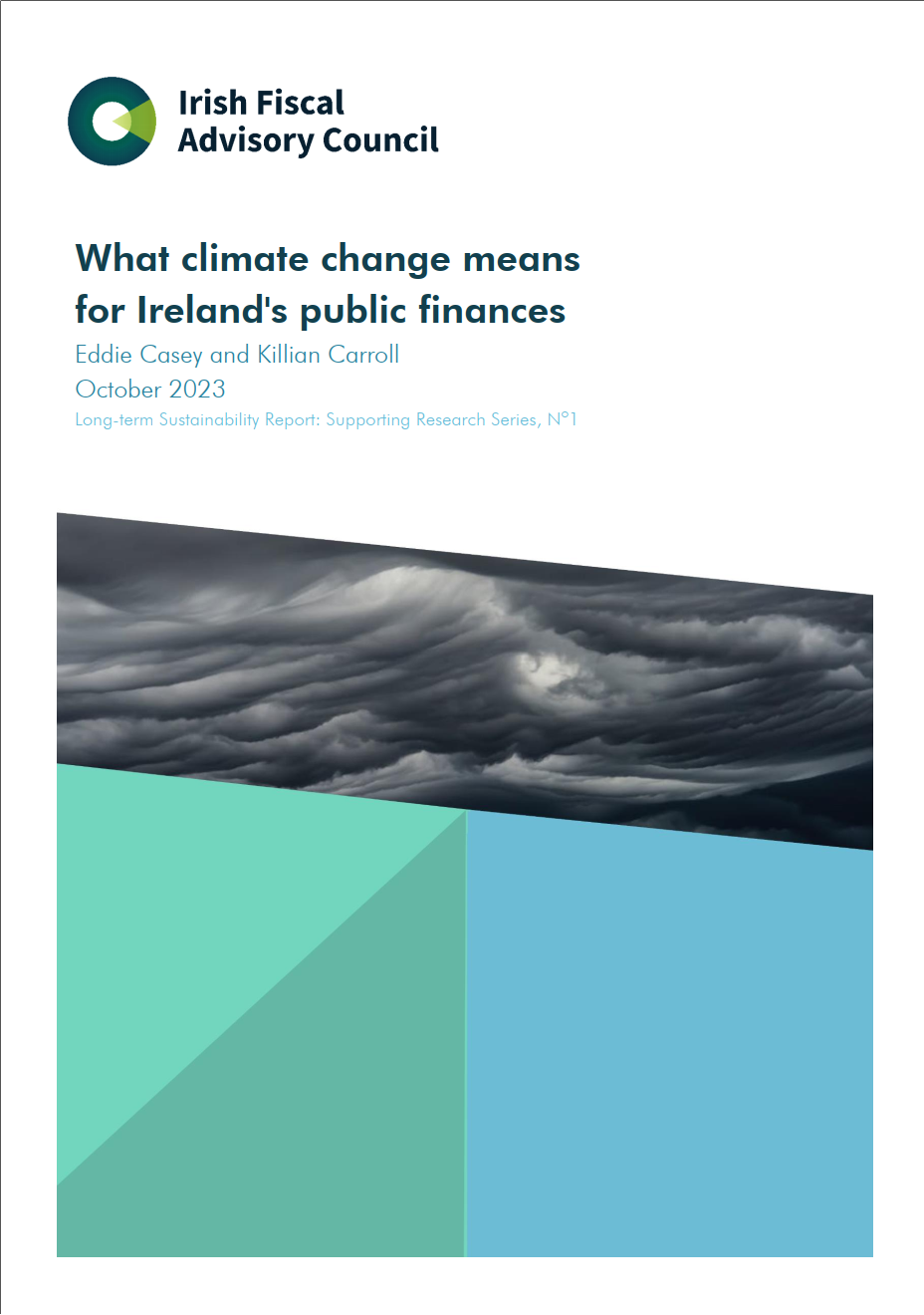What climate change means for Ireland’s public finances
This paper is part of a new series of research outputs that supports the Council’s assessments of the long-term sustainability of the public finances.
The series is specifically intended to provide analysis and research that feeds into the Council’s Long-term Sustainability Reports.
What climate change means for Ireland’s public finances
Eddie Casey and Killian Carroll
October 2023
Long-term Sustainability Report: Supporting Research Series, Nº1
Summary
The climate is changing.
Long-run data points to clear trends in Ireland of rising temperatures, increased rainfall, and more frequent extreme weather events.
A changing climate in Ireland and globally will impact the Irish economy and the public finances. There will be some costs associated with the transition to a less carbon-intensive economy, with the possibility of not hitting legal requirements, and from facing up to more regular extreme weather events.
Of course, there will also be opportunities in moving towards a more sustainable growth model, including through lower imports of fossil fuels and less pollution.
Assessing the likely impacts related to climate, we consider three avenues through which the public finances will be affected:
1) Compliance costs
Ireland is legally bound to achieve carbon neutrality by 2050 and to stay within three sequential carbon budgets between 2021 and 2035. These require greenhouse gas emissions to be reduced by 51% by 2030 compared to 2018 levels.
However, projections for Ireland based on existing plans show it missing its requirements. These indicate a reduction of just 29% by 2030.
Failing to meet these targets would incur some compliance costs.
Estimates by Walker et al. (2023) put the costs at an annual average of about €0.35 billion up to 2030, when costs rise to €0.7 billion (0.2% of GNI*).
2) Transition costs
Even if Ireland’s climate targets are met in full, there will be a range of substantial impacts on the public finances.
First, on the revenue side — and assuming unchanged tax rates — meeting Ireland’s climate targets could see tax revenues reduced by 0.9% of GNI* (€2.5 billion in today’s terms) per annum by 2030. This would rise to as much as 1.6% of GNI* (€4.4 billion) per annum in the long run.
Most of this is due to a few factors:
1) a sharp decrease in tax on fuel and energy use, which stems from lower excise duties and reduced petrol and diesel consumption,
2) the lower VAT rates on electricity, and
3) the decrease in vehicle registration tax and motor tax, which are both tied to emissions under current policies.
Second, on the spending side, the Government will also likely need to provide substantial supports if Ireland’s climate targets are to be met.
Some of the adjustment will be carried out by the private sector. That is, many of the actions needed will sufficiently benefit private households and businesses as to be financially cost effective without Government intervention.
However, a lot of the actions needed will have to be taken rather quickly, further tightening financial constraints on households and businesses.
Depending on the extent of private sector involvement, we estimate that the Government may face costs of between 0.6 and 1.1% of GNI* (€1.6 to 3.0 billion in today’s terms) per annum over the years 2026 to 2030. These costs could then average between 0.4 and 0.7% of GNI* (€1.1 to 1.9 billion in today’s terms) over the longer term from 2031 to 2050.
3) Physical Risks (costs associated with extreme weather events)
There could also be additional costs arising from the State having to provide supports to respond to more frequent and more adverse extreme weather events.
Ireland has seen an increase in major weather events over time. Increased rainfall and rising temperatures carry risks of more regular flooding and wildfires. When these events occur, the costs associated with them could be in the region of 0.2% of GNI* (about €0.5 billion in today’s money).
Limiting these risks could require further adaptation costs beyond the €0.1 billion per annum allocated for flood defences in the National Development plan.
More work is needed
The estimates presented here are very much provisional attempts to estimate the fiscal impacts associated with climate change and the climate transition.
This work is a first step. There is much to be done to better understand the impacts of climate change on the public finances. In this context, we are mindful that many of the costs look set to emerge towards the end of this decade — a period not too distant, but one generally not covered by official budgetary forecasts.
We hope to continue to develop this work and further refine our estimates in time — including by allowing for various indirect effects, such as the impact on economic activity from higher investment and lower taxes — and we welcome further feedback on our approach.
Data pack
This pack includes some of the key charts and data in the report.

